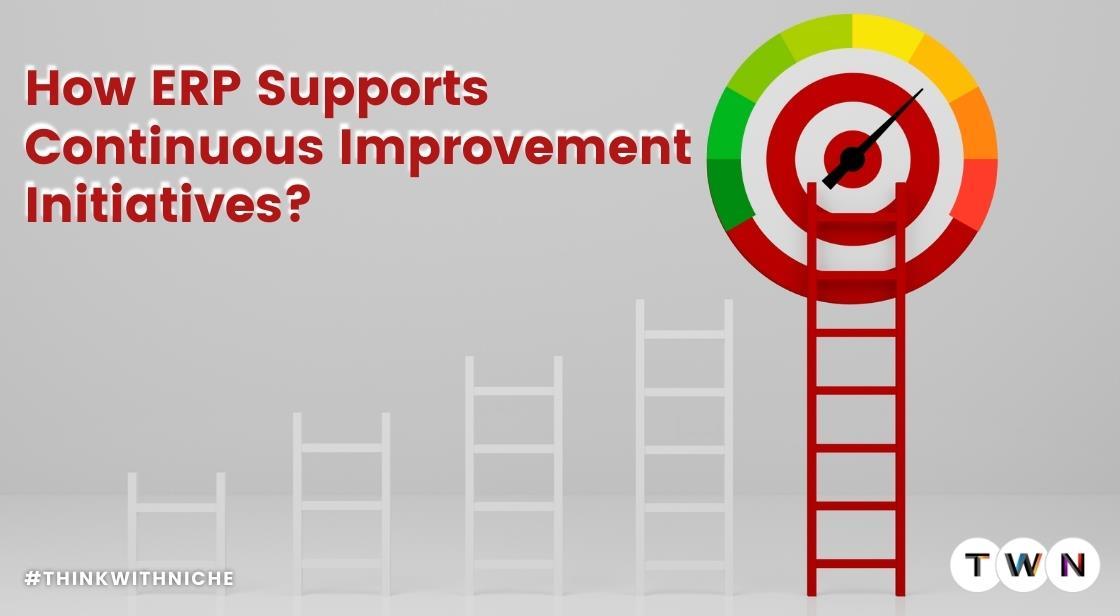How ERP Supports Continuous Improvement Initiatives

Blog Post
In today’s competitive manufacturing landscape, small process tweaks can yield massive results- but only if you have the right tools to track and execute them.
Discover how ERP transforms continuous improvement from a concept into a measurable, profit-driving reality for your business.
Introduction- Driving Operational Excellence Through ERP
Continuous improvement is not just a manufacturing buzzword; it is a disciplined approach to making your operations smarter, faster, and more efficient. But here is the reality- without the right systems in place, even the most dedicated improvement initiatives can stall.
That is where Enterprise Resource Planning (ERP) becomes a game-changer.
ERP is no longer just an administrative tool.
It is an operational backbone that connects people, processes, and data in real time, creating a seamless flow of information that powers data-driven decisions.
By integrating ERP into your improvement strategy, you’re equipping your teams with the insights and agility they need to respond to challenges instantly and improve continuously.
The Link Between ERP and Continuous Improvement
From reducing waste to enhancing customer satisfaction, ERP helps identify bottlenecks, standardize workflows, and align teams towards common goals.
Instead of relying on fragmented data or guesswork, decision-makers can tap into unified dashboards that track key metrics across the organization.
With ERP, continuous improvement shifts from being reactive to proactive- enabling you to prevent problems before they arise, maintain consistency across processes, and foster collaboration between departments and suppliers.
Why You Must Read This Blog Post
If you are serious about scaling your manufacturing operations, this blog post is your roadmap to integrating ERP into your continuous improvement plan.
Here you will discover:
- The role of ERP in increasing data transparency.
- How automation and standardization enhance process efficiency.
- Ways to foster collaboration across departments and suppliers.
- The impact of real-time monitoring on timely decision-making.
- Strategies for resource optimization and cost control.
Whether you are already using an ERP system or considering implementation, this guide will help you maximize its value and transform it into a powerhouse for sustained operational excellence.
The philosophy of continuous improvement is critical when manufacturing companies want to improve the quality, eliminate waste, and achieve a general improvement in all aspects of the operations. This continuous method is reserved to minor increments that lead to improved performance and satisfaction of the customers. To make such initiatives, numerous manufacturers depend on the technology that helps gather real-time data, streamline workflows, and promote collaboration. An Enterprise Resource Planning System or as it is popularly called, "ERP" is one such solution. ERP systems have now gone beyond the basic resource management and are tremendously powerful tools that help in constant enhancement during the manufacturing operation.
The blog post/ article discusses the use of ERP in assuring continuous improvement and the advantage it can be used to give the manufacturers that are determined to remain competitive.
ERP Provides Data Visibility For Better Decision Making
Perhaps the best contribution ERP makes to continuous improvement is the ability to present a coherent picture of data anywhere and everywhere in an organization. Manufacturing companies have to handle huge information such as the levels of production, storage, supplier-level trade and quality analytics. In the absence of a common system, such data is normally in silos and this makes it tedious to interpret and take action. ERP consolidates such information which helps managers and groups to consume correct, updated information using one platform. This visibility assists in knowing in real time the bottlenecks, inefficiencies as well as areas of improvement.
The availability of reliable and specific data is central to the continuous improvement process in that manufacturers can measure the performance against some key metrics continuously. ERP systems can be used to trace quality defects and downtime of equipment and damages of the production, which can be used to take measures. These insights enable teams to take specific actions and observe the effect of the changes they make, or in other words, build a feedback loop that will help make continuous improvements. ERP can retain a data-driven, improvement-oriented culture by easing the process of making data-driven choices.
ERP Enhances Process Standardization And Workflow Automation
Standardized processes must be in place so that continuous improvement can take place through the review and optimization of the processes. ERP facilitates this requirement since it can allow manufacturers to capture, enforce, and automate processes throughout the company on a regular basis. Process standardization will eliminate variation and errors which are paramount in the realization of quality and efficiency objectives. ERP systems may have a workflow management component built-in that automatically routing tasks, approvals and notifications as per a pre-defined rule to allow everyone to best practice.
Manufacturing ERP also enables the automation of mundane tasks, by taking away the employees who are engaged in manual repetitive tasks and involving them in more value-adding jobs. As an example, an ERP may direct that inventory be replenished when it harms an idea of demand, or cause maintenance downtimes when an equipment has topped particular use rates. Such automation eliminates the possibility of error caused by a human factor, and increases responsiveness rates, which helps to maintain continuous improvement. With increasingly predictable workflows, manufacturers will find it easier to see where changes can make the most radical difference.
ERP Supports Collaboration Across Departments
The process of continuous improvement is not incorporated into the singular operation of the manufacturing process, but it presupposes cooperation work among various teams such as production, quality, supply chain, finance, and so forth. ERP systems are a shared ground on which, these departments can have exchange of information and ability to coordinate their activities better. Once all can access the same data and tools, communication is better, and fewer misunderstandings or communication lapses occur.
ERP supported teamwork also enables the destruction of conventional silos which act as a possible breaker of efforts geared at improvements. ERP reports and dashboards may be used by cross-functional teams to discuss, together, the performance of key processes and to collaborate in prioritizing improvement projects. Then, ERP makes supplier collaboration superior because it allows seeing supplies and delivery plans thus aligning outside partners with internal objectives. ERP aids in continuous improvement over an extended period because it builds a culture of team spirit and shared responsibility.
ERP Facilitates Real-Time Monitoring And Continuous Feedback
Among those listed, ensuring timely information is essential to continuous improvement, with by far one of the strengths of the ERP systems being an ability to offer real-time monitoring of manufacturing processes. Most of the current ERP solutions have provisions such as live dashboards and notifications that alert managers about performance variances or possible errors in real-time. It is this swiftness that enables teams to respond promptly and reduce the adverse effects, and instead experience even growth towards the targets of improvement.
Learning and adaptation in a manufacturing environment must have habits of continuous feedback loops. ERP also facilitates such loops because it allows performance data to be collected and analyzed on a continuous in-time basis. The system would allow employees with issues to report directly instead of involving supervisors who may take too long to solve the cases, and corrective measures can also be recorded and monitored. The process of giving such structured feedback will have the lesson of one cycle being used to make the next one better, in order to build a culture of never-ending improvement.
ERP Enables Better Resource Allocation And Cost Management
Continuous improvement is focused on the effective use of resources and ERP allows the effective use of resources and cost control. ERP contributes to manufacturers by ensuring that the resources are organized according to the demand estimations and other operational priorities through integration of production planning, inventory management, and financial modules. The result of this orientation is less waste in terms of excessive inventory or idle equipment, which are detrimental to the endeavors of an improvement initiative.
ERP also improves cost management by giving clear information on the use of materials, man hours and overhead costs. Managers can be able to establish cost drivers as well as assessing returns on investment on different improvement programs with such information at their disposal. The budgeting and reporting features of ERP help improve the financial plans and allow financing the continuous improvement initiatives, tracking their progress. Consequently, producers will be able to maintain advances without reducing the profitability.
Conclusion: ERP a Strategic Partner for Continuous Improvement
In an era where market demands evolve faster than production lines, ERP stands out as a strategic enabler of continuous improvement. Its real strength lies in combining granular visibility with process discipline, ensuring every improvement effort is backed by accurate data and actionable insights.
ERP systems not only remove inefficiencies but also embed a culture of accountability, collaboration, and forward-thinking across the organization. By aligning improvement initiatives with your ERP capabilities, you create a self-sustaining cycle where progress is measured, lessons are captured, and innovations are quickly integrated into daily operations.
The result? Stronger competitiveness, better customer experiences, and long-term profitability- all rooted in a unified, data-driven approach.
Key Takeaways for Readers
- ERP is a strategic partner in continuous improvement, not just an operational tool.
- Data visibility fuels smarter decisions, enabling teams to detect and address inefficiencies quickly.
- Standardization and automation reduce errors, streamline processes, and enhance quality outcomes.
- Cross-departmental collaboration breaks silos, aligning teams toward shared performance goals.
- Real-time monitoring ensures faster responses to challenges and supports ongoing optimization.
- Efficient resource allocation and cost control boost ROI and sustain improvement momentum.
Reader’s Disclaimer: The views and insights shared in this blog post/ article are intended solely for educational and informational purposes. ThinkWithNiche does not endorse or promote any specific company, software, or service mentioned herein. Readers are encouraged to conduct their own research before making business decisions.
You May Like
EDITOR’S CHOICE












